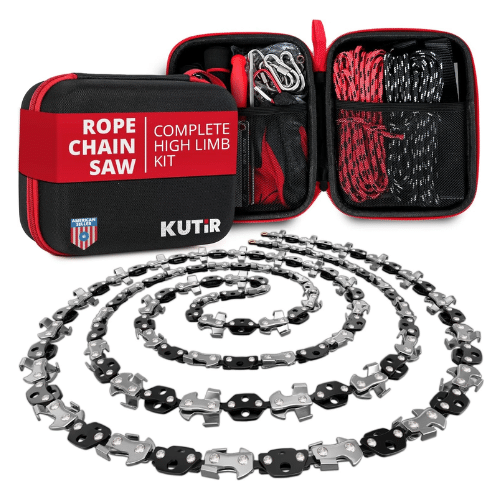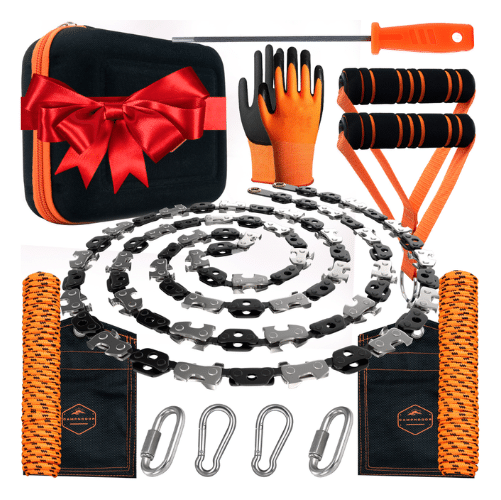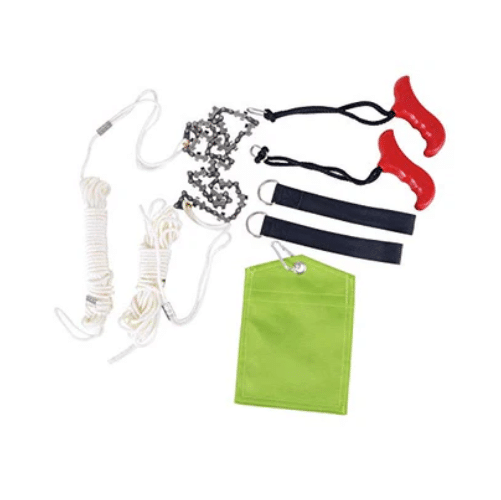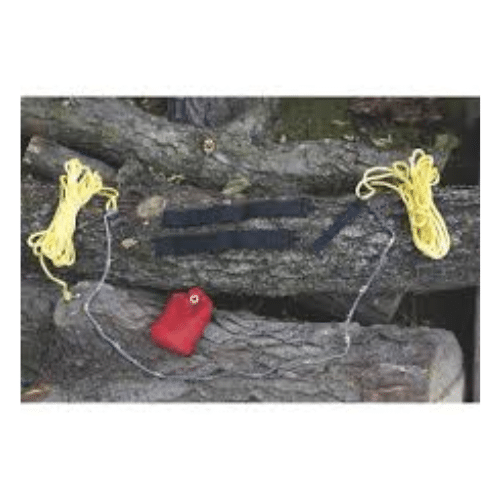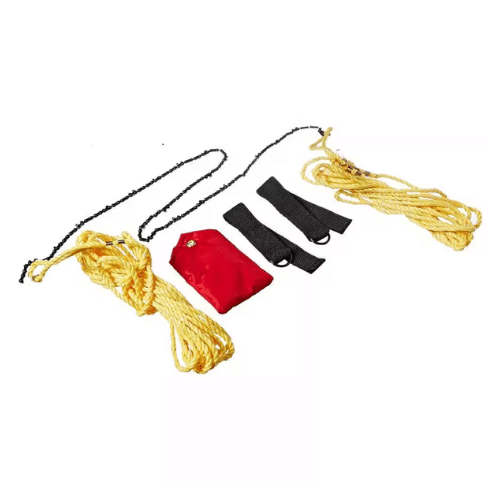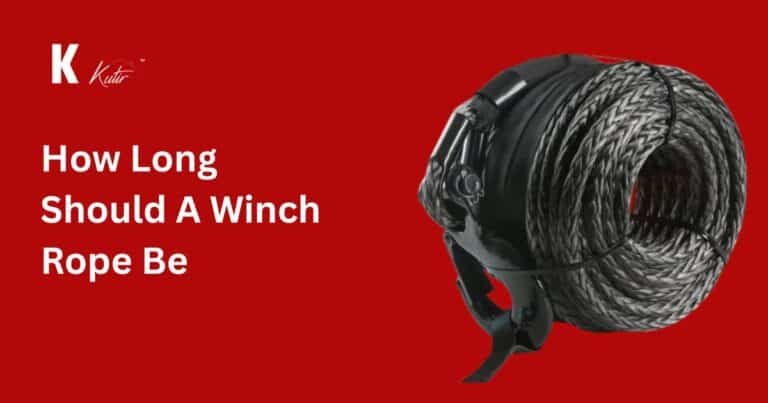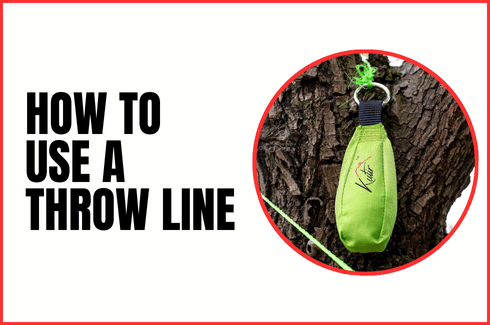Looking for the best rope saw for tree limbs to keep your trees neat and healthy? You’re in the right place. The best rope saw for tree limbs is a tool with a strong steel chain, bi-directional cutting teeth, and durable ropes long enough to reach high branches safely from the ground.
Rope saws make cutting tree branches easily without ladders or heavy power tools. Instead, they use a flexible chainsaw blade attached to ropes that you throw over the branch and pull back and forth. This design makes them safer, lighter, and more affordable compared to pole saws or chainsaws for high tree trimming.
If you’ve ever struggled with branches hanging too close to your roof or blocking sunlight in your yard, a rope saw will solve that problem in minutes. In this guide, I’ll walk you through the top options, features to look for, and real tips to use them confidently.
At Kutir Tools, we believe tree trimming should feel simple, safe, and satisfying every time.
Why Rope Saws Are Perfect for Cutting Tree Limbs
Rope saws are ideal for trimming high tree branches without leaving the ground. You don’t need ladders or expensive lifts, which keeps you safer during yard work.
They use a strong chainsaw blade attached to ropes. You throw the chain over the branch and pull each side to cut. This makes it easy to reach limbs far above your head.
Rope saws are lightweight and compact. You can carry them anywhere and store them easily in your shed or toolbox. They work well for thick branches that pole saws can’t reach.
Using a rope saw saves time and money. You handle tree trimming on your own without hiring professionals, keeping your yard neat all year.
Rope Saw vs. Other Tree Cutting Tools
| Tool | What It Does Best | Good Points | Bad Points |
| Rope Saw | Cutting very high branches | Safe to use from the ground, light to carry, and low cost | Needs practice to throw rope well, cuts slower |
| Pole Saw | Reaching medium-height limbs | Easy for branches up to 15 ft, good control | Heavy when fully extended, can’t reach very high |
| Chainsaw | Cutting thick branches and trunks | Powerful, fast cutting for large jobs | Must climb ladder or tree, risky, needs fuel |
| Hand Pruners | Trimming small, low branches | Very light, simple to use, precise cuts | Can’t cut thick or high branches |
| Loppers | Cutting thin, low to mid branches | Easy to handle, no fuel needed | Limited reach and cutting thickness |
Final Note: Rope saws are the best choice if you want to cut high tree limbs safely without climbing or using heavy, noisy tools.
Top 5 Best Rope Saws for Tree Limbs
1. Kutir Tools High Limb Rope Saw (48″)
After testing several models, this saw consistently impressed us with its balance of cutting speed and ease of use. It’s a fantastic all-around choice for most homeowners dealing with high branches.
For those wanting a much deeper analysis, we’ve prepared a complete, hands-on review of the 48-inch hand rope chainsaw. In our detailed breakdown, we cover its performance on different types of wood, long-term durability tests, a full list of pros and cons, and tips for getting the most out of it.
2. CAMPNDOOR High Limb Rope Saw (53″)
This is a great choice if you need to cut very high branches. It comes with a 53-inch chain that has bi-directional teeth for fast cuts. The ropes are strong, long, and come with good grip handles. It’s light to carry and easy to pack in your yard tools bag. People like it because it slices through big branches without making your arms feel like jelly.
3. Timber Tuff High Limb Rope Saw (28″)
Looking for something budget-friendly but reliable? This one is perfect for regular yard trimming. It has a 28-inch steel chain with sharp teeth, two 20-foot ropes, and a weighted throw bag. It’s super light and easy to set up, making it great for quick weekend trimming jobs on small to medium branches.
4. Northern Tool Professional Rope Saw (48″)
This rope saw won’t let you down if you deal with tough, thick branches often. It has a 48-inch durable steel chain with bi-directional teeth for efficient cutting. You get two 25 ft strong ropes with sturdy handles. It’s slightly heavier because it’s built for professional-level work. Perfect if you cut thick tree limbs regularly and need something strong and reliable.
5. Home Depot 48″ Manual Rope Saw
If you want an affordable but still effective saw, this is a good choice. It has a 48-inch carbon steel chain with standard teeth and comes with around 50 feet of rope. It’s lightweight and easy to store in your garage. Many homeowners say it works best when you pull smoothly and steadily, making cuts clean without tiring yourself out.
How to Use a Rope Saw for Cutting Tree Limbs Safely
Check Your Surroundings First
Before anything, look around the tree. Make sure no one is standing under the branch you plan to cut – not your kids, your pets, or your favourite garden statue. Safety comes first, always.
Get Ready to Throw
Now, here comes the fun part. Attach a throw weight or a small bag to one end of the rope. Take a deep breath and toss it over the branch like you’re aiming for the winning shot in basketball. Don’t worry if you miss the first few tries – even the best of us do.
Position the Chain Properly
Alright, now we move on to another interesting step. Adjust both rope ends so the saw chain teeth sit flat against the branch. Double-check that it’s exactly where you want to cut. Random cuts make trees look like a bad haircut, and no one wants that.
Start Cutting Smoothly
Hold both rope ends tight. Begin pulling one side, then the other, in steady back-and-forth motions. Think of it like gently sawing through a fresh loaf of bread. Don’t pull too hard or too fast. Slow and steady always wins when using a rope saw.
Stay Safe While You Work
Here comes another important tip. Wear gloves to protect your hands and safety glasses to keep bark or dust out of your eyes. If the branch is big, pop on a helmet too. Better safe than sorry.
Clean Up and Store Properly
And now we move to the final interesting step. As the branch starts to fall, step back and admire your work. Once it’s down, remove the saw, wipe the chain clean, and coil your ropes neatly. Trust me, you don’t want to deal with a tangled rope mess next time.
Rope Saw Accessories You Should Have
- Grab a weighted throw bag. It makes tossing your rope over high branches so much easier. Without it, you’ll end up throwing all day and getting nowhere.
- Next, get a strong throw line. Go for Dyneema. It’s light, super strong, and slides over branches without getting stuck.
- Always keep non-conductive ropes if you’re working near power lines. Trust me, it’s not worth the risk.
- You’ll also want comfortable handles. Pulling rough ropes hurts your hands fast. Good handles keep you cutting longer without pain.
- Don’t forget a carry bag. It keeps your saw, ropes, and throw bag together. No more hunting around your garage for missing pieces.
- Lastly, have a chain sharpening file. A sharp chain cuts faster and saves your arms from getting tired.
Key Features to Look for Before Buying a Rope Saw
Strong Chain Quality
First, always check the chain quality. A strong steel or carbon steel chain cuts branches smoothly without bending or breaking. Trust me, a cheap chain snapping mid-cut is the last thing you want.
Long Enough Rope
Now we move on to another important point. Look at the rope length. Longer ropes help you reach high branches easily. If the rope is too short, you’ll struggle and waste time re-throwing it again and again.
Bi-Directional Teeth
Here’s a cool tip many people forget. Choose a chain with bi-directional teeth. It cuts both ways when you pull each side of the rope. This makes your cuts faster and saves your energy.
Comfortable Handles
Let’s talk comfort for a moment. Check if the saw has good handles with a firm grip. Cutting high branches takes time, and sweaty hands on thin ropes can make the job harder than it should be.
Lightweight and Easy to Carry
Another feature to look for is weight. Rope saws are meant to be easy to carry. If the kit is heavy with bulky throw weights, it can slow you down and feel like an arm workout you didn’t ask for.
Safety Features
Finally, safety always matters. Non-conductive ropes are a must if you’re cutting near power lines. Also, having a carry bag keeps your saw neat and safe from rust or tangles.
Expert Tree Cutting Tips for Homeowners
Think of late winter as your tree’s “spa season” – it’s resting, bare, and ready for a little TLC before spring’s big show. Without leaves in the way, you can easily spot which branches need to go (like that dead one that’s been bugging you all year).
Start with the obvious troublemakers – the dead, broken, or weak limbs. It’s like removing splinters before they cause problems. When you make your cuts, angle them like a roof pitch – this lets rainwater roll right off instead of pooling (because nobody wants a soggy, rotting wound).
Quick safety check: Glance down and move anything you’d hate to crush – that garden gnome collection isn’t going to protect itself! As you work, imagine you’re buttering toast – smooth, steady strokes with your rope saw work way better than frantic hacking.
And please – suit up like you’re gardening in a sci-fi movie: gloves for rope burn, glasses for flying wood chips, and maybe a helmet if you’re dealing with the big stuff. Your future self (with all fingers intact) will thank you.
Frequently Asked Questions
Question: How do I keep my rope saw chain sharp?
Answer: Wipe your chain clean after each use and store it dry to avoid rust. Use a small sharpening file regularly to keep the teeth sharp, which makes your cuts smoother and easier.
Question: Is a rope saw better than a pole saw for high branches?
Answer: Yes, rope saws work better for very high branches beyond pole saw reach. Pole saws are easier for branches up to 15 feet, but rope saws are safer and more practical for limbs that require ladder climbing otherwise.
Question: Can I use a rope saw near power lines?
Answer: No, never use a rope saw near power lines. Even if your ropes are non-conductive, it’s too risky. Always call a professional for branches close to electrical wires.
Question: Do rope saws damage the tree bark?
Answer: If used correctly with slow, steady cuts, rope saws make clean cuts that don’t damage bark. Avoid quick jerky pulls as they can tear the bark and harm the tree.
Question: How high can a rope saw reach?
Answer: Most rope saws can reach branches up to 30-40 feet, depending on your rope length and throwing skill. This makes them perfect for trimming trees without using ladders.
Final Recommendation
Choosing the right rope saw makes tree trimming safer, easier, and much less tiring. If you want a tool that’s strong, reliable, and built to last, go for the Kutir Tools High Limb Rope Saw. It’s designed to handle thick branches with ease and keeps your yard looking neat all year.
With its sharp steel chain, strong ropes, and comfortable handles, you’ll feel confident tackling any tree-trimming job. Take your time, use smooth, steady pulls, and always stay safe. A good rope saw, like Kutir Tools, makes tree cutting feel like a simple win every time you head out to work in your yard.

